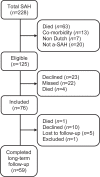Fatigue in relation to long-term participation outcome in aneurysmal subarachnoid haemorrhage survivors
- PMID: 33604676
- PMCID: PMC8814890
- DOI: 10.2340/16501977-2800
Fatigue in relation to long-term participation outcome in aneurysmal subarachnoid haemorrhage survivors
Abstract
Objective: To examine the association of fatigue with long-term participation in aneurysmal subarachnoid haemorrhage survivors.
Design: Cohort study, 4 years post-onset.
Subjects: A total of 59 patients with aneurysmal subarachnoid haemorrhage.
Methods: Participation performance was assessed with the Sickness Impact Profile-68, participation autonomy and problem experience with the Impact on Participation and Autonomy questionnaire, and community integration with the Community Integration Questionnaire. Fatigue was assessed with the Fatigue Severity Scale and depression with the Center for Epidemiologic Studies-Depression scale. Multivariable linear regression analyses were performed.
Results: Fifty-nine survivors (mean age 53.0 years, standard deviation (SD) 10.8 years) were included, of which 59.3% was fatigued. Fatigued patients had significantly worse participation scores than non-fatigued patients regarding performance (p < 0.001), autonomy indoors (p = 0.001), autonomy outdoors (p = 0.002) and problem experience (p = 0.001), but not regarding community integration. More severe fatigue was related to worse participation in terms of performance (B = 2.79, p < 0.001) and problem experience (B = 0.08, p = 0.003), adjusted for depression and inpatient rehabilitation.
Conclusion: Four years after onset, many survivors of aneurysmal subarachnoid haemorrhage have persistent fatigue, which is independently associated with reduced participation in activities of daily living. Therefore, future studies should investigate whether rehabilitation programs that focus on fatigue are effective in improving long-term participation outcome after aneurysmal subarachnoid haemorrhage.
Keywords: community integration; depression; fatigue; rehabilitation; social participation; stroke; subarachnoid haemorrhage.
Conflict of interest statement
Figures
Similar articles
-
Fatigue is Associated with Reduced Participation and Health-Related Quality of Life Five Years After Perimesencephalic Subarachnoid Haemorrhage: A Multicentre Cross-Sectional Study.J Rehabil Med. 2022 May 11;54:jrm00271. doi: 10.2340/jrm.v54.212. J Rehabil Med. 2022. PMID: 35191989 Free PMC article.
-
Differences in cognitive and emotional outcomes between patients with perimesencephalic and aneurysmal subarachnoid haemorrhage.J Rehabil Med. 2014 Jan;46(1):28-32. doi: 10.2340/16501977-1236. J Rehabil Med. 2014. PMID: 24158233
-
Long-Term Functioning of Patients with Aneurysmal Subarachnoid Hemorrhage: A 4-yr Follow-up Study.Am J Phys Med Rehabil. 2016 Feb;95(2):112-20. doi: 10.1097/PHM.0000000000000353. Am J Phys Med Rehabil. 2016. PMID: 26135378
-
[Idiopathic subarachnoid hemorrhage; comparison of different bleeding patterns and long-term outcome].Neurocirugia (Astur). 2002 Apr;13(2):110-9. doi: 10.1016/s1130-1473(02)70630-1. Neurocirugia (Astur). 2002. PMID: 12058602 Review. Spanish.
-
A Systematic Review of Cognitive Outcomes in Angiographically Negative Subarachnoid Haemorrhage.Neuropsychol Rev. 2018 Dec;28(4):453-469. doi: 10.1007/s11065-018-9389-1. Epub 2018 Oct 23. Neuropsychol Rev. 2018. PMID: 30353304
Cited by
-
Unraveling the interplay between daily life fatigue and physical activity after subarachnoid hemorrhage: an ecological momentary assessment and accelerometry study.J Neuroeng Rehabil. 2023 Sep 26;20(1):127. doi: 10.1186/s12984-023-01241-5. J Neuroeng Rehabil. 2023. PMID: 37752550 Free PMC article.
-
Fatigue is Associated with Reduced Participation and Health-Related Quality of Life Five Years After Perimesencephalic Subarachnoid Haemorrhage: A Multicentre Cross-Sectional Study.J Rehabil Med. 2022 May 11;54:jrm00271. doi: 10.2340/jrm.v54.212. J Rehabil Med. 2022. PMID: 35191989 Free PMC article.
-
Daily patterns of fatigue after subarachnoid haemorrhage: an ecological momentary assessment study.J Rehabil Med. 2023 Oct 18;55:jrm6486. doi: 10.2340/jrm.v55.6486. J Rehabil Med. 2023. PMID: 37853923 Free PMC article.
References
-
- Macdonald RL, Schweizer TA. Spontaneous subarachnoid haemorrhage. Lancet 2017; 389: 655–666. - PubMed
-
- Rinkel GJ, Algra A. Long-term outcomes of patients with aneurysmal subarachnoid haemorrhage. Lancet Neurol 2011; 10: 349–356. - PubMed
-
- Nieuwkamp DJ, Setz LE, Algra A, Linn FH, de Rooij NK, Rinkel GJ. Changes in case fatality of aneurysmal subarachnoid haemorrhage over time, according to age, sex, and region: a meta-analysis. Lancet Neurol 2009; 8: 635–642. - PubMed
-
- Al-Khindi T, Macdonald RL, Schweizer TA. Cognitive and functional outcome after aneurysmal subarachnoid hemorrhage. Stroke 2010; 41: e519–536. - PubMed
MeSH terms
LinkOut - more resources
Full Text Sources
Other Literature Sources
Medical


